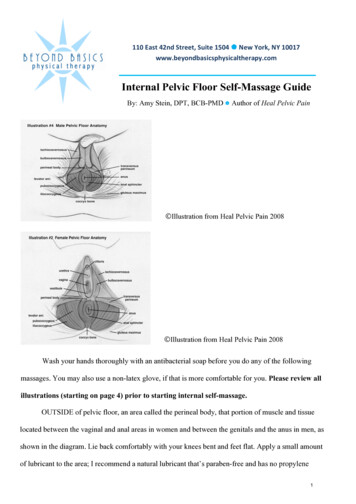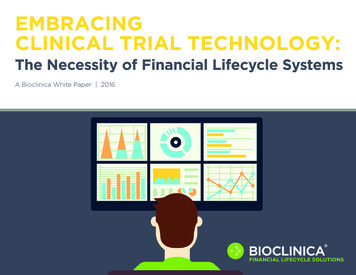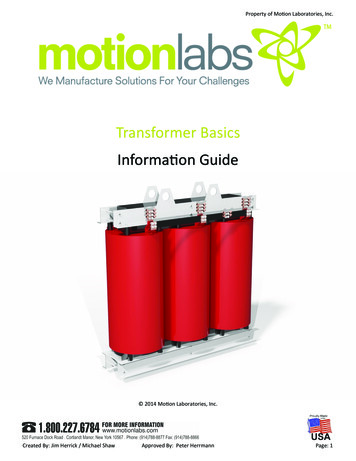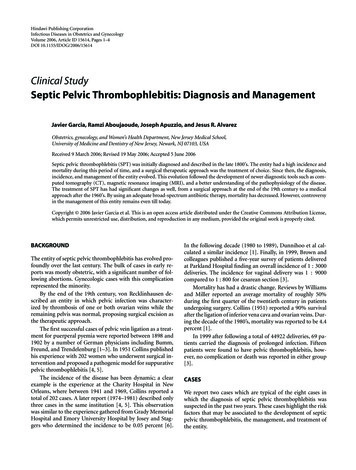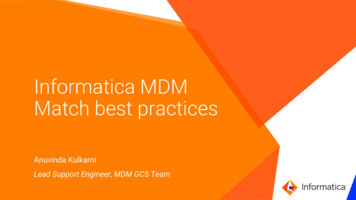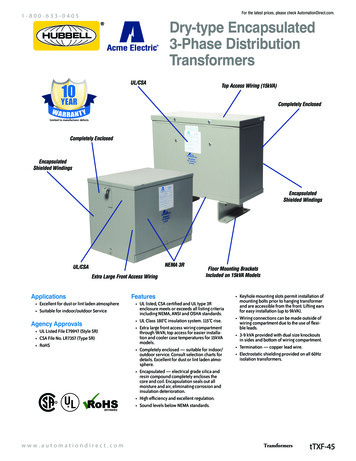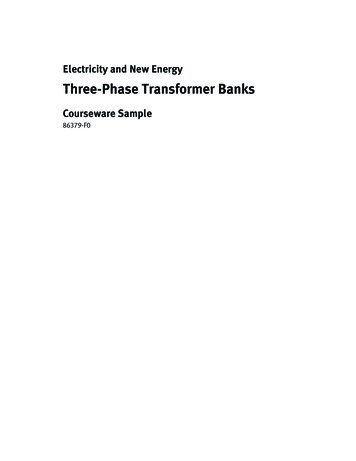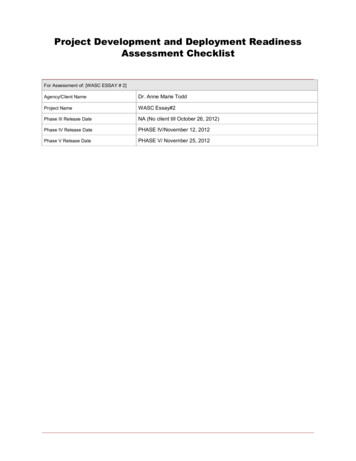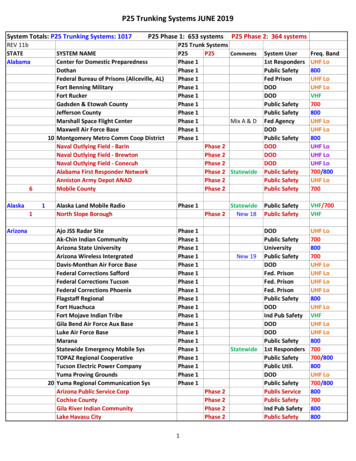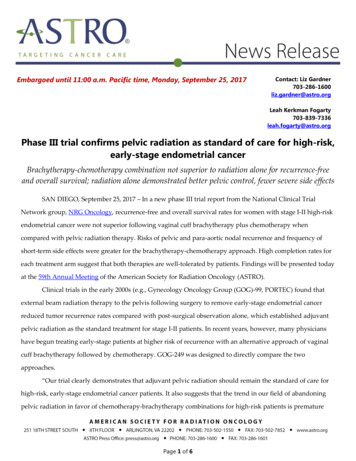
Transcription
Embargoed until 11:00 a.m. Pacific time, Monday, September 25, 2017Contact: Liz Gardner703-286-1600liz.gardner@astro.orgLeah Kerkman Fogarty703-839-7336leah.fogarty@astro.orgPhase III trial confirms pelvic radiation as standard of care for high-risk,early-stage endometrial cancerBrachytherapy-chemotherapy combination not superior to radiation alone for recurrence-freeand overall survival; radiation alone demonstrated better pelvic control, fewer severe side effectsSAN DIEGO, September 25, 2017 – In a new phase III trial report from the National Clinical TrialNetwork group, NRG Oncology, recurrence-free and overall survival rates for women with stage I-II high-riskendometrial cancer were not superior following vaginal cuff brachytherapy plus chemotherapy whencompared with pelvic radiation therapy. Risks of pelvic and para-aortic nodal recurrence and frequency ofshort-term side effects were greater for the brachytherapy-chemotherapy approach. High completion rates foreach treatment arm suggest that both therapies are well-tolerated by patients. Findings will be presented todayat the 59th Annual Meeting of the American Society for Radiation Oncology (ASTRO).Clinical trials in the early 2000s (e.g., Gynecology Oncology Group (GOG)-99, PORTEC) found thatexternal beam radiation therapy to the pelvis following surgery to remove early-stage endometrial cancerreduced tumor recurrence rates compared with post-surgical observation alone, which established adjuvantpelvic radiation as the standard treatment for stage I-II patients. In recent years, however, many physicianshave begun treating early-stage patients at higher risk of recurrence with an alternative approach of vaginalcuff brachytherapy followed by chemotherapy. GOG-249 was designed to directly compare the twoapproaches.“Our trial clearly demonstrates that adjuvant pelvic radiation should remain the standard of care forhigh-risk, early-stage endometrial cancer patients. It also suggests that the trend in our field of abandoningpelvic radiation in favor of chemotherapy-brachytherapy combinations for high-risk patients is prematurePage 1 of 6
Embargoed until 11:00 a.m. Pacific time, Monday, September 25, 2017and not supported by clinical evidence,” said Marcus Randall, MD, FASTRO, lead author of the study and aprofessor of radiation medicine at the University of Kentucky in Lexington. “The cohort of women with highrisk histologies did not demonstrate any benefit from the addition of chemotherapy, but they did experienceworse nodal control rates and more short-term side effects.”GOG-249 was a phase III randomized trial designed to test whether adjuvant brachytherapy pluschemotherapy improved recurrence-free survival compared with the standard treatment of pelvic radiationfor early-stage, high-risk endometrial cancer. Eligible patients included women with high-risk stage I-IIhistology, including stage II tumors, stage I-II serous or clear-cell carcinomas and stage I endometrioidtumors if the patient demonstrated clinic-pathologic features associated with a high risk of recurrence, basedon criteria established in the GOG-33 trial and used in the GOG-99 trial.Most patients (74%) had stage I disease and endometrioid histology (71% versus 15% serous and 5%clear-cell carcinomas). The median patient age was 63 years. All patients underwent hysterectomy prior toradiation or chemoradiation therapy.One of two treatment arms was randomly assigned to patients: adjuvant external beam RT to thepelvis (PXRT) or vaginal cuff brachytherapy plus chemotherapy (VCB/C). The PXRT group (n 301 patients)received a median radiation dose of 45 Gray (Gy) delivered over five weeks through standard four-fieldradiation or intensity-modulated radiation therapy (IMRT). Patients with serous, clear-cell or stage II tumorswere eligible for a vaginal cuff brachytherapy boost, and 35 percent of the cohort received this additionaltherapy. The VCB/C group (n 300 patients) received either high-dose rate (HDR) or low-dose rate (LDR)brachytherapy followed by three cycles of chemotherapy including paclitaxel (175 mg/m 2 – 3 hour) andcarboplatin (AUC 6 – 21 days). Nearly all 601 patients accrued for the trial completed treatment (91% PXRT,87% VCB/C).There were no statistically significant increases in recurrence-free survival (RFS) or overall survival(OS) in the brachytherapy-chemotherapy arm. At a median follow-up of 53 months, 82 percent of patientswere alive and recurrence free at three years for both the VCB/C and PXRT patient groups. Three-year OS rateswere 91 percent for pelvic radiation and 88 percent for the brachytherapy-chemotherapy combination, but thisdifference was not statistically significant (p 0.57). Survival distributions were estimated using the KaplanMeier method and compared using a log rank test.The cumulative incidence of pelvic or para-aortic nodal recurrence at five years among the VCB/Cgroup (9.2%, 25 recurrences, 20 in the pelvis) was twice that of the pelvic radiation cohort (4.4%; 12recurrences, 6 in the pelvis) (Hazard Ratio (HR) 0.47, 95% CI 0.24-0.94). The cumulative incidence of vaginalPage 2 of 6
Embargoed until 11:00 a.m. Pacific time, Monday, September 25, 2017and distant tumor recurrences, however, did not differ significantly between the groups. The cumulativeincidence of distant recurrence at five years was 18 percent for both groups.Short-term side effects were more pronounced on the brachytherapy-chemotherapy arm, while longterm side effects were similar for both treatments. Grade 3 or higher adverse events were reported in 187patients receiving VCB/C, compared with 32 patients in the PXRT group. Severe late effects, or side effects thatoccurred after treatment ended, were reported in 35 patients who received VCB/C and 37 who received PXRT.Side effects were graded using the Common Terminology Criteria for Adverse Events (CTCAE) version 3.“Previous GOG trials confirmed that pelvic radiation is an effective, safe and tolerable option tomanage early-stage endometrial cancer. The current trial confirms that this standard treatment is preferable tothe experimental approach of vaginal cuff brachytherapy followed by chemotherapy, in terms of tumor controlin the nodal regions and also in terms of acute toxicity. This finding holds true even for patients at a higherrisk of recurrence,” said Dr. Randall. “Researchers can focus now on determining the optimal radiation dosingand fractionation schedules for various patient sub-groups, as well as refining the techniques we use to deliverexternal beam therapy to the pelvis and continue to investigate therapies to decrease distant failures in thishigh-risk group.”The abstract, “A phase III trial of pelvic radiation therapy versus vaginal cuff brachytherapy followedby paclitaxel/carboplatin chemotherapy in patients with high-risk, early-stage endometrial cancer: AGynecology Oncology Group study,” will be presented in detail during a news briefing and the PlenarySession at ASTRO’s 59th Annual Meeting in San Diego (full details below). To schedule an interview with Dr.Randall and/or outside experts in gynecologic cancer, contact ASTRO’s media relations team on-site at the SanDiego Convention Center September 24 through 27, by phone at 703-286-1600 or by email at press@astro.org.###ATTRIBUTION TO THE AMERICAN SOCIETY OF RADIATION ONCOLOGY (ASTRO) ANNUALMEETING REQUESTED IN ALL COVERAGE.This news release contains additional and/or updated information from the study author(s). Full originalabstract and author disclosures available on the final page of this release.Study Presentation Details News Briefing: Monday, September 25, 11:00 a.m. – 12:00 p.m. Pacific, San Diego Convention Center,room 24C, webcast: http://www.bit.do/astro17-2 Scientific Session: Plenary, Monday, September 25, 2:15 – 3:45 p.m. Pacific time, San Diego ConventionCenter, Ballroom 20Page 3 of 6
Embargoed until 11:00 a.m. Pacific time, Monday, September 25, 2017Resources on Gynecologic Cancer and Radiation Therapy Digital brochure: Radiation Therapy for Gynecologic Cancers Videos: Radiation Therapy for Gynecologic Cancers (Spanish version), An Introduction to RadiationTherapy (Spanish version) Additional brochures, videos and information on radiation therapy from ASTRO’s patient site,RTAnswers.org ASTRO’s clinical practice statements and guidelinesABOUT ASTRO’S ANNUAL MEETINGASTRO’s 59th Annual Meeting, the world’s largest scientific meeting in radiation oncology, will be held September 2427, 2017, at the San Diego Convention Center. The 2017 Annual Meeting is expected to attract more than 11,000attendees from across the globe, including oncologists from all disciplines and members of the entire radiation oncologyteam. More than 2,800 abstracts sharing results from clinical trials and other research studies will be presented inconjunction with educational sessions and keynote addresses that underscore the meeting’s theme, “The Healing Art andScience of Radiation Oncology.” Led by ASTRO President Brian Kavanagh, MD, MPH, FASTRO, the 2017 meetingwill feature keynote addresses from Richard D. Zane, MD, FAAEM, Chief Innovation Officer for the University ofColorado Health System; Lucy Kalanithi, MD, FACP, widow of Paul Kalanithi, MD, the best-selling author of “WhenBreath Becomes Air,” with Heather Wakelee, MD, Paul’s oncologist; and Vinay K. Prasad, MD, MPH, an assistantprofessor of medicine at the Oregon Health & Science University. During the four-day meeting, more than 200 exhibitorswill demonstrate cutting-edge technology and medical device innovations for radiation oncology. Visit us online for moreinformation about ASTRO’s 59th Annual Meeting or press opportunities at the meeting.ABOUT ASTROThe American Society for Radiation Oncology (ASTRO) is the world’s largest radiation oncology society, with more than10,000 members who are physicians, nurses, biologists, physicists, radiation therapists, dosimetrists and other health careprofessionals who specialize in treating patients with radiation therapies. The Society is dedicated to improving patientcare through professional education and training, support for clinical practice and health policy standards, advancementof science and research, and advocacy. ASTRO publishes three medical journals, International Journal of RadiationOncology Biology Physics (www.redjournal.org), Practical Radiation Oncology (www.practicalradonc.org) andAdvances in Radiation Oncology (www.advancesradonc.org); developed and maintains an extensive patient website, RTAnswers (www.rtanswers.org); and created the Radiation Oncology Institute (www.roinstitute.org), a nonprofitfoundation to support research and education efforts around the world that enhance and confirm the critical role ofradiation therapy in improving cancer treatment. To learn more about ASTRO, visit www.astro.org and follow us on ourblog, Facebook and Twitter.Page 4 of 6
Embargoed until 11:00 a.m. Pacific time, Monday, September 25, 2017Abstract LBA-1: A phase III trial of pelvic radiation therapy versus vaginal cuff brachytherapy followed bypaclitaxel/carboplatin chemotherapy in patients with high-risk, early-stage endometrial cancer: AGynecology Oncology Group studyM. Randall1, V. Filiaci2, D. McMeekin3, C. M. Yashar4, R. Mannel3, R. Salani5, P. DiSilvestro6, J. Burke7, T.Rutherford8, N. Spirtos9, J. Cho10, J. Kim11,12, P. Anderson13, W. Brewster14, W. Small15, M. Carney16, C.Aghajanian17, and D. S. Miller18; 1University of Kentucky, Lexington, KY, 2NRG Oncology Statistics and DataManagement Center, Buffalo, NY, 3University of Oklahoma, Oklahoma City, OK, 4University of California San Diego,San Diego, CA, 5The Ohio State University, Columbus, OH, 6Brown University, Providence, RI, 7Memorial University,Savannah, GA, 8Yale Gynecologic Oncology, New Haven, CT, 9Women's Cancer Center of Nevada, Las Vegas, NV,10University of Hawaii, Honolulu, HI, 11Seoul National University, Seoul, Korea, Republic of (South), 12KoreanGynecologic Oncology Group, Seoul, Korea, Republic of (South), 13Fox Chase Cancer Center, Philadelphia, PA,14University of North Carolina, Chapel Hill, NC, 15Loyola University Medical Center, Maywood, IL, 16University ofHawaii Cancer Center, Honolulu, HI, 17Memorial Sloan Kettering Cancer Center, New York, NY, 18University of TexasSouthwestern, Dallas, TXPurpose/Objective(s): To determine if vaginal cuff brachytherapy and chemotherapy (VCB/C) could increaserecurrence-free survival (RFS) compared to pelvic external beam radiation therapy (PXRT). Secondaryobjectives included comparisons of overall survival (OS), patterns of failure, and frequency/severity of adverseevents between the treatment arms.Materials/Methods: A randomized phase III trial was performed in endometrial cancer patients meetingeligibility criteria. All patients were required to undergo hysterectomy. Eligible patients had stage Iendometrioid histology with GOG 99-based high intermediate risk criteria (based on age, tumor grade, depthof invasion, and presence of lymphovascular space invasion), stage II, or stage I-II serous (S) or clear cell (CC)tumors. Central pathology review was performed. Patients assigned to PXRT were treated with standard 4field or Intensity-Modulated Radiation Therapy (IMRT) techniques to a mean dose of 45 Gy over 5 weeks.Additional VCB was optional for patients with S/CC tumors or stage II disease. Patients assigned to VCB/Creceived HDR or LDR brachytherapy followed by paclitaxel 175 mg/m2 (3 hour) carboplatin AUC 6 q 21days for a total of 3 cycles.Results: A total of 601 pts were accrued; PXRT was assigned to 301 (18 did not receive study treatment) andVCB/C to 300 (9 did not receive study treatment). The median age was 63 years, 74% had stage I disease, and89% underwent lymphadenectomy. Histology included 71% with endometrioid type, 15% S, and 5% CC.Nearly all pts completed the prescribed therapy (91% PXRT, 87% VCB/C). In the PXRT arm, IMRT was used in36%, and vaginal cuff brachytherapy boost was added in approximately 35%. Acute toxicity was morecommon and more severe with VCB/C. Grade 3 or higher adverse events were reported in 32 patients on thePXRT arm versus 187 patients on the VCB/C arm. Grade 3 or higher late effects were seen in 37 and 35 patientson the PXRT and VCB/C arms, respectively. With a median follow-up of 53 months, the 36 month RFS was82% for both PXRT and VCB/C. The 36 month OS was 91% vs 88% for PXRT and VCB/C, respectively. Nosignificant differences were noted between the two arms in terms of vaginal or distant failure. However, pelvicor para-aortic nodal recurrences were significantly more common in the VCB/C arm (25 vs 12), largely drivenby the difference in pelvic nodal failure (20 vs 6 patients). There was no statistically significant treatment effectheterogeneity with respect to RFS among clinical-pathologic variables evaluated.Conclusion: This study did not demonstrate a superiority of VCB/C to PXRT in women with HR endometrialcancer. Acute and late toxicity and pelvic and para-aortic nodal failure were more frequent in the VCB/C arm.Page 5 of 6
Embargoed until 11:00 a.m. Pacific time, Monday, September 25, 2017Both arms appeared to be well tolerated with high completion rates. PXRT remains an effective, well-tolerated,and acceptable adjuvant treatment in patients with high risk, early-stage endometrial carcinoma.Author Disclosures: M. Randall: Uterine Corpus Com; GOG/NRG. V. Filiaci: Research Grant; National CancerInstitute. Service Agreement for conducting research; GOG Foundation, Inc. participates in the executivecommittee; NRG Oncology Statistics and Data Management Center. D. McMeekin: None. C.M. Yashar:Employee; Abreos Biosciences. Partner; Kaiser Permanente. Advisory Board; Cianna Medical, MicroChips.Travel Expenses; MicroChips. Chair the committee for hospital credentialing; University of California SanDiego; American College of Radiation Oncology, University of California San Diego. Chair meetings forreview educational programs. R. Mannel: help lead organization; GOG Foundation. Group Chair; NRG. R.Salani: None. P. DiSilvestro: None. J. Burke: None. T. Rutherford: None. N. Spirtos: None. J. Cho: None. J. Kim:None. P. Anderson: None. W. Brewster: None. W. Small: Research Grant; Carl Zeiss. Speaker's Bureau; CarlZeiss. Advisory Board; Varian. Travel Expenses; Carl Zeiss. Board Member; Loyola University Health System.ACR Leadership; ACR. Research; NRG Oncology, RTOG. M. Carney: None. C. Aghajanian: Honoraria; Clovis.Steering Committee Member; Mateon. D.S. Miller: Research Grant; Genentech, Merrimack, Novartis. AdvisoryBoard; Genentech. Chair; NRG Oncology.Page 6 of 6
There were no statistically significant increases in recurrence-free survival (RFS) or overall survival (OS) in the brachytherapy-chemotherapy arm. At a median follow-up of 53 months, 82 percent of patients were alive and recurrence free at three years for bo
